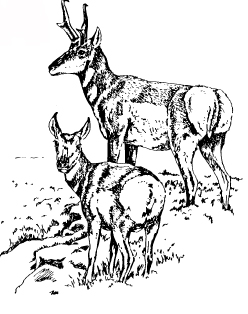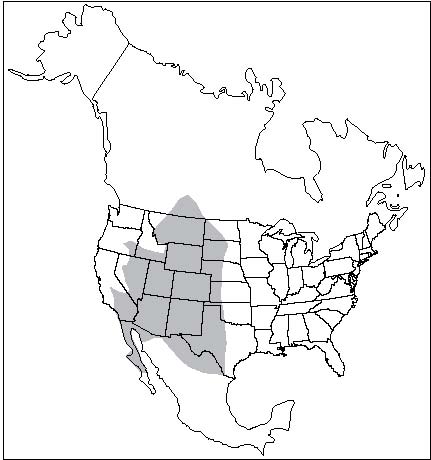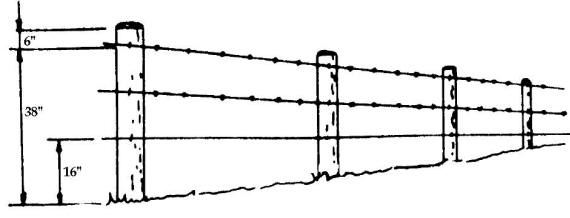|
|
|
|
 |
OTHER MAMMALS: Pronghorn Antelope |
|
|

Fig. 1. Pronghorn
antelope, Antilocapra americana
Identification
The pronghorn (Antilocapra
americana) is not a true antelope but in a family by
itself (Antilocapridae). It is native only to
North America.
The pronghorn is the only
North American big game animal that has branched horns,
from which its name derives. Pronghorns have true horns
— derived from hair — not antlers. The horns have an
outer sheath of fused, modified hair that covers a
permanent, bony core. Pronghorns shed the hollow outer
sheath each year in October or November and grow a new
set by July. Both bucks and does have horns, but doe
horns are shorter and more slender. Adult pronghorns
stand 3 feet (90 cm) high at the shoulders. Bucks weigh
about 110 pounds (50 kg); does weigh about 80 pounds (36
kg). Pronghorns have a bright reddish-tan coat marked
with white and black. The buck has a conspicuous black
neck patch below the ears, which is lacking on the doe.
At a distance, their markings break up the outline of
their body, making them difficult to see. Their white
rump patch is enlarged and conspicuous when they are
alarmed. The flash of white serves as a warning signal
to other pronghorns and is visible at long distances.

Fig. 2. Range of the pronghorn in North America.
Range
Pronghorns currently have
a scattered but widespread distribution throughout
western North America (Fig. 2)
In the early 1800s, when
the Lewis and Clark expedition recorded the presence of
large herds of pronghorn, the total population across
North America was estimated at 35 million. In less than
100 years, however, intensive market hunting brought
pronghorn numbers to a low of approximately 13,000.
Quick action by conservation-minded leaders saved the
pronghorn from possible extinction.
In the late 1800s and
early 1900s most Great Plains state legislatures passed
laws making it unlawful to kill, ensnare, or trap
pronghorns.
Pronghorns were given
complete protection for nearly 50 years. In the 1940s
and 1950s, limited hunting seasons were permitted, and
pronghorn seasons have been held ever since in most
Great Plains states. Populations have shown a notable
increase in the last 2 decades.
A game management success
story documents an increase from a population low of a
few bands of pronghorn in Nebraska during the early
1900s to a current population of about 7,000. Trapping
and transplanting programs to reestablish pronghorn
populations by the state wildlife agencies and proper
management and protection have been major factors in the
pronghorn’s recovery.
Habitat
Pronghorns thrive in short
and mixed grasslands and sagebrush grasslands. They
prefer rolling, open, expansive terrain at elevations of
3,000 to 6,000 feet (900 to 1,800 m), with highest
population densities in areas receiving an average of 10
to 15 inches (25 to 38 cm) of precipitation annually.
Vegetation heights on good pronghorn ranges average 15
inches (38 cm) with a minimum of 50% ground cover of
mixed vegetation. Healthy pronghorn populations are
seldom found more than 3 to 4 miles (4.8 to 6.4 km) from
water.
Pronghorns sometimes
migrate between their summer and winter ranges. Since
they seldom jump over objects more than 3 feet (90 cm)
high, most fences stop them unless they can go under or
through them. The construction of many highways with
parallel fencing has greatly altered the migratory
patterns of pronghorns. Woven wire fences, in
particular, are a barrier that impede pronghorn
movements to water, wintering grounds, and essential
forage. Proper spacing of barbed wire in fences (Fig. 3)
is essential to allow adequate pronghorn movement.
Food Habits
Pronghorns eat a variety
of plants, mostly forbs and browse. Sagebrush often
makes up a large part of their diet. They are dainty
feeders, plucking only the tender, green shoots.
Pronghorns compete with sheep for forbs, but are often
found on summer cattle ranges where cattle eat the
grasses, leaving the forbs and browse. Dietary overlap
of pronghorns with sheep and cattle was 40% and 15%,
respectively, in New Mexico. In the winter, pronghorns
often feed in winter wheat and alfalfa fields.
General Biology, Reproduction, and Behavior
Pronghorns depend on their
eyesight and speed to escape enemies. Their eyes
protrude in such a way that they can see in a side
direction. They prefer to live on the open plains where
they can see for long distances. Pronghorns are the
fastest North American big game animal and can reach
speeds of up to 60 miles per hour (96 kph).

Fig. 3. Specifications for livestock fences constructed
on antelope ranges, recommended by the US Bureau of Land
Management Regional Fencing Workshop (1974).
Pronghorns are social
animals, gathering in relatively large herds. In spring,
however, bucks are alone or form small groups.
Pronghorns breed during September and October. Bucks are
polygamous, collecting harems of 7 to 10 does, which
they defend from other bucks. Bucks and does begin
breeding at 15 to 16 months of age. Usually 2 kids
(young) are born 8 months after mating. The kids are
grayish brown at birth and usually weigh 5 to 7 pounds
(2.3 to 3.2 kg). Does nurse their kids and keep them
hidden until they are strong enough to join the herd,
usually at 3 weeks of age. By fall, the kids can take
care of themselves and are somewhat difficult to
distinguish from adults.
Pronghorns are relatively
disease- and parasite-free. Losses occur from predation,
primarily coyote, and starvation during severe winters
with prolonged deep snow.
Damage
Pronghorns sometimes cause
damage to grain fields, alfalfa, and haystacks during
the winter. Damage occurs from feeding, bedding, and
trampling.
Legal Status
Pronghorns have
game-animal status in all of the western states. Permits
are required to trap or shoot pronghorns.
Damage Prevention and Control Methods
Exclusion
Woven wire fences of 8-inch (20-cm) mesh, 48 inches
(1.2 m) high, near agricultural fields will help to
curtail damage. Electric fences with two wires spaced at
8 to 10 inches (20 to 25 cm) and 3 feet (90 cm) above
the ground will discourage pronghorns from entering
croplands. A single strand of electric wire painted with
molasses as an attractant and 30 to 36 inches (76 to 91
cm) above the ground will discourage pronghorn access.
Cultural Methods
Plant tall crops, such as corn, as a barrier between
rangelands and small grain fields to help reduce damage.
Alfalfa fields adjacent to rangeland are more vulnerable
and apt to suffer damage. Pronghorns often move out of
pastures that are heavily grazed by cattle to ungrazed
areas.
Frightening
Propane or acetylene exploders may provide temporary
relief from crop damage. These devices are also used for
bird damage control (see Bird Dispersal Techniques and
Supplies and Materials).
Repellents None are
registered.
Toxicants None are
registered, and poisoning pronghorns also violates state
laws that protect them as game animals.
Trapping
In areas where crop depredation and livestock
competition are severe, pronghorns can be readily herded
with aircraft into corral traps. After capture, they can
be translocated into suitable unoccupied habitat. This
technique is for use only by federal or state wildlife
agencies.
Shooting
Encourage legal hunting near agricultural fields to
help curtail crop damage. Shooting permits are available
in some states to remove pronghorns that are causing
significant damage outside of the regular hunting
season.
Economics of Damage and Control
Competition with livestock
and occasional damage to agricultural crops should be
weighed against the economic value of pronghorns as game
animals. Landowners in Texas and other Great Plains
states often charge $200 or more for trespass fees per
hunter. Guided hunts may yield $600 to $800 or more per
animal taken. In addition, many landowners derive
aesthetic pleasure from observing pronghorns. Some
states provide economic reimbursement for crop damage.
In Wyoming, costs of pronghorn crop damage on private
land, including administration (for example, salaries
and travel) averaged $169,453 per year (1987 to 1991).
Similar antelope crop damage costs in Colorado for the
same period averaged $5,510 per year.
Acknowledgments
Figure 1 by Charles W. Schwartz, adapted from
Yoakum (1978) by Emily Oseas Routman.
Figure 2 from Burt and
Grossenheider (1976), adapted by Jill Sack Johnson.
Figure 3 from the US
Bureau of Land Management (1974).
For Additional Information
Kitchen, D. W., and B. W. O’Gara. 1982. Pronghorn. Pages
960-971 in J. A. Chapman and G. A. Feldhamer, eds. Wild
mammals of North America: biology, management and
economics. The Johns Hopkins Univ. Press, Baltimore,
Maryland.
O’Gara, B. W. 1978.
Antilocapra americana. Mammal. Sp. 90:1-7.
US Bureau of Land
Management. 1974. Proc. Regional Fencing Workshop.
Washington, DC. 74 pp.
Yoakum, J. D. 1978.
Pronghorn. Pages 102-122 in
J. L. Schmidt and D. L.
Gilbert, eds. Big game of North America. Wildl. Manage.
Inst. and Stackpole Books, Harrisburg, Pennsylvania.
Yoakum, J. D., and B. W.
O’Gara. 1992. Pronghorn antelope: ecology and
management. Wildl. Manage. Inst. (in prep).
Yoakum, J. D., and D. E.
Spalinger. 1979. American pronghorn antelope - articles
published in the Journal of Wildlife Management
1937-1977. The Wildl. Soc., Washington, DC. 244 pp.
Editors
Scott E. Hygnstrom Robert
M. Timm Gary E. Larson
D-74
Special
thanks to:
Clemson University
|